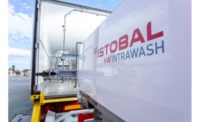With its roots in many high-profile food safety crises in the United States, the Food Safety Modernization Act (FSMA) has Hazard Analysis and risk-based preventive controls at its core and focuses on building in preventive tools and processes to minimize future food safety issues and on streamlining recall procedures. It mandates that facilities must implement controls for identified hazards, continually monitor the performance of such controls, take corrective measures as required and document protocol for all procedures.
The need for the regulation and its focus on prevention is clear: According to the U.S. Food and Drug Administration, one in six Americans each year is plagued by foodborne illnesses.[1] However, the path to FSMA compliance—with all of the challenges it may pose to efficiency, sustainability and the resources of food and beverage companies—may be murky.
In today’s competitive food industry, companies that succeed will leverage advanced technologies and processes to achieve regulatory compliance without compromising efficiency, and packaging machinery suppliers are pacing ahead to present innovations that accomplish just that.
Here’s a look at some key packaging technology features and trends to drive compliance with present and future regulations, while also feeding the bottom line.
Cleaning As Simple As 1-2-3
Due to the emphasis on Hazard Analysis and risk prevention, equipment sterilization and cleaning processes are under rigorous scrutiny. Several equipment advances can help streamline efficiency in all areas.
Clean-in-place technologies can generate big-time cost savings, as can open designs that provide easy access to all machine parts. For example, larger clearances above and under packaging equipment enable faster cleaning and maintenance processes.
Many packaging technology suppliers are also designing equipment with FSMA in mind by minimizing surface areas where moisture and food particles can collect and facilitate bacterial growth, eliminating points of risk. Incorporating smooth welds and avoiding exposed fasteners and crevices can reduce instances of dirt and debris accumulation. Using angled surfaces can prevent the pooling of water, cleaning agents or other liquids to further reduce food safety risks. Finally, using more stainless steel in equipment constructs, especially for parts that come into contact with food, is another way to accommodate new standards.
Get Modular
Ensuring equipment cleaning and sanitation between product runs is absolutely critical, especially considering the need to avoid cross-contamination due to allergies. Yet this process is often time-consuming, causing bottlenecks in production and hurting output.
Using modular equipment that can be swapped out for new, clean components allows operators to ready equipment for production while another setup is in action. That means cleaning between packaging runs can be done offline, avoiding production stoppages, preventing cross-contamination and allowing the flexibility needed to package the wide variety of products that consumers demand.
To make this work, modular packaging equipment must have intuitive interfaces and make it easy to quickly disconnect and reconnect hardware. Clean/sterilize-in-place functionality that eliminates or minimizes the need for disassembly and reassembly is another necessity.
The Power of Automation
It’s well known that humans are a major source of risk in food production and packaging operations, and using robotics and automation in packaging lines is one way to minimize this risk while also enhancing flexibility and reducing changeover times. Packaging technology with digital presets, self-cleaning features and machine-to-machine communication capabilities is helpful in achieving efficiency and complying with regulations both today and tomorrow.
Quality Monitoring
In addition to building quality assurance into a packaging line, it’s important to continue to verify quality, and there are many technologies to assist. In-line quality monitoring equipment such as vision inspection systems, X-ray inspection systems and metal detectors can be installed throughout a line to identify quality and food safety issues and keep them from reaching the market. Risk-mitigation equipment such as cap sanitizing systems can also be advantageous. Whether identifying foreign particles or product deformities, these systems provide a line of defense against noncompliance and costly recalls.
The key for success for such in-line technology is proper installation and validation as well as performance checking. Well-documented and regularly followed performance verification processes are necessary to ensure proper function and meet regulations.
Track and Trace
Document, document, document. This is a core ethos of the FSMA regulations, and advanced track-and-trace capabilities make a difference here. Hardware and software capable of providing the coding and database information needed to authenticate products from the point of packaging to the point of purchase can help companies meet traceability requirements. If a product quality problem is detected, pedigree information can be used to quickly identify, locate and recall affected products.
Proper track-and-trace tool kits usually include coders or printers to apply bar codes to containers, labels or packaging materials. The latest technologies are moving toward two-dimensional bar codes, as they retain more information on product and ingredient origins than their one-dimensional counterparts. Packaging lines also require inspection systems to verify code quality and capture information.
As more and more data are tracked and stored, the need for more robust databases able to handle and communicate these data throughout the global supply chain becomes more urgent. Cloud-based solutions are discussed as potential answers, but security concerns remain a hot-button issue.
The Right Setup
Proper line setup can contribute to FSMA compliance, and packaging equipment suppliers can provide guidance here. From preventing contamination with physical barriers between high- and low-risk areas to optimizing the flow of materials via equipment positioning, there are many factors to consider. Suppliers can advise on measures to streamline production traffic and prevent cross-contamination with airflow to minimize food safety risks and maximize output.
The Human Element
While technology advances can make it easier to comply with regulations, the human element cannot be ignored. Tools and training must be put in place to ensure proper operation and adherence to new processes.
The first step is documenting standard operating procedures for equipment use and sanitation procedures—and the processes in place should a contamination event occur. This should be followed by rigorous operator training on the new regulations and reporting requirements, proper equipment cleaning procedures and inspecting for potential sources of microbial contamination or allergen residue.
Again, packaging machinery suppliers and organizations can be used as resources. Take advantage of supplier workshops and documentation to bring operators up to speed.
Finding It All
In the food industry, there is no room for cutting corners with regard to safety and quality. With FSMA compliance in mind, food manufacturers must have a clear plan of action to prevent product contamination up- and downstream. Advanced packaging technology that’s easy to clean, modular and automated can make implementation of this plan easier, as can knowledgeable equipment partners.
Jeff Barach, Ph.D., is a FSMA consultant to PMMI, The Association for Packaging and Processing Technologies, which owns and produces the PACK EXPO family of trade shows. Visit www.packexpointernational.com for more information.
Reference
1. www.fda.gov/Food/guidanceregulation/FSMA/ucm334115.htm.
FSMA Compliance with a Competitive Edge




